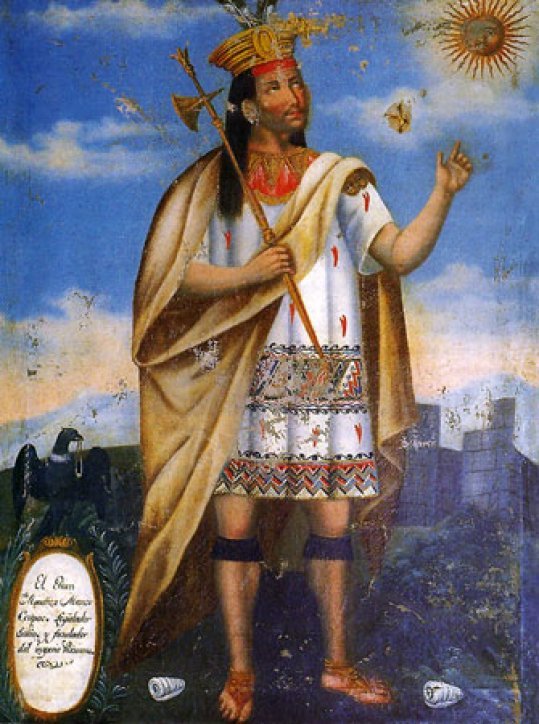<
 According to the instructions, he had to plant this staff in the ground. The location where it sank without resistance would be the perfect location for him and his people to settle.
Following his father’s demands, Manco Cápac ventured through the Andes Mountains and the surrounding valleys searching for good land. He finally came across the Cusco valley where he thrust his golden staff into the earth.
It sank into the earth without resistance. So, Manco Cápac led his sister/wife and his people to this location where they settled circa 1200.
This is the foundational myth of the Inca empire, however, there is also historical proof of Manco Cápac’s existence. Historians believe that he was born in Tamputoco, which is located in the province of Pumaurco in present-day Peru.
The city of Tamputoco was a refuge for many nomads that were exiled by the Aymaran invasions. According to some sources, Manco Cápac became the head of the Ayllu people after the death of his father, Manqu Qhapaq.
The Ayllu was a nomadic tribe comprised of several dozens of families. The trajectory of their journeys through the Cusco valley coincides with Manco Cápac’s journey as told in the legends.
Their settlement in the Cusco valley wasn’t effortless, however. The area was divided into four districts and the Ayllu people only occupied a small fraction. At the time, the other districts were inhabited by larger, more powerful tribes.
Manco Cápac and the Ayllu people were regarded as invaders and were thus often attacked. It wasn’t until the late 14thcentury, with the expansion of the Inca empire, that their people became the most powerful tribe.
Manco Cápac died of natural causes and left his son, Sinchi Roca, in charge of the city of Cusco and their tribe. His body was mummified and kept in the city until the reign of Pachacuti in the 15thcentury, who demanded its move to Lake Titicaca. Today, only a statue of him remains in the city of Cusco to honor his legacy.]]>
According to the instructions, he had to plant this staff in the ground. The location where it sank without resistance would be the perfect location for him and his people to settle.
Following his father’s demands, Manco Cápac ventured through the Andes Mountains and the surrounding valleys searching for good land. He finally came across the Cusco valley where he thrust his golden staff into the earth.
It sank into the earth without resistance. So, Manco Cápac led his sister/wife and his people to this location where they settled circa 1200.
This is the foundational myth of the Inca empire, however, there is also historical proof of Manco Cápac’s existence. Historians believe that he was born in Tamputoco, which is located in the province of Pumaurco in present-day Peru.
The city of Tamputoco was a refuge for many nomads that were exiled by the Aymaran invasions. According to some sources, Manco Cápac became the head of the Ayllu people after the death of his father, Manqu Qhapaq.
The Ayllu was a nomadic tribe comprised of several dozens of families. The trajectory of their journeys through the Cusco valley coincides with Manco Cápac’s journey as told in the legends.
Their settlement in the Cusco valley wasn’t effortless, however. The area was divided into four districts and the Ayllu people only occupied a small fraction. At the time, the other districts were inhabited by larger, more powerful tribes.
Manco Cápac and the Ayllu people were regarded as invaders and were thus often attacked. It wasn’t until the late 14thcentury, with the expansion of the Inca empire, that their people became the most powerful tribe.
Manco Cápac died of natural causes and left his son, Sinchi Roca, in charge of the city of Cusco and their tribe. His body was mummified and kept in the city until the reign of Pachacuti in the 15thcentury, who demanded its move to Lake Titicaca. Today, only a statue of him remains in the city of Cusco to honor his legacy.]]>

